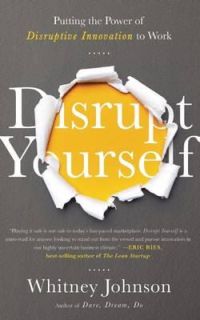
Disrupt Yourself: Putting the Power of Disruptive Innovative to Work
by Whitney Johnson
Clayton Christensen introduced the concept of disruptive innovation in The Innovator’s Dilemma, his seminal book which focused on the computer industry. His successive books applied the concept to health care and education. Now, Whitney Johnson writes about disrupting your own career.
Johnson defines disruptive innovation as “innovation at the low end of the market that eventually upends an industry.” Established market leaders tend to put their resources into sustaining innovations for which there is clear demand from their customers. Disruptive innovations are more often brought to market by start-ups who find their beachhead in a niche market.
The book explains the distinction between competitive risk and market risk. “One of the key attributes ascribed to disruptors is that they play where no one else is playing. Whether you are a low-end disruptor or a new-market disruptor, you will find yourself pioneering your way to a market that has yet to be defined.” The author cites a study of “forty companies that were identified as disruptive (i.e., took on market risk) in the ten years after they went public, the average price/earnings multiple for these stocks was 30x, or double that of the broader market… When you are disrupting, the best possible start-up scenario is to be dismissed, even ignored” by competitors.
Johnson presents the S-curve to illustrate “the necessary pivots in our own career paths… Remember that at the beginning of this S-shaped curve, progress will be slow… The looming mountain may seem insurmountable, but the S-curve helps us understand that if we keep working at it, we can reach that inflection point where our understanding and competence will suddenly shoot upward.”

“The whole point of disruption is to move up the y-axis of success, however you define success, over the x-axis of time. When you disrupt yourself, you are making a conscious decision to move down the y-axis, leaving a comfortable perch, possibly with pay and status taking a hit, on the premise that the slope of your next curve will be even steeper, leading to another period of rapid growth up the success curve. Just make sure you’re not jumping onto the wrong grid.”
“Disruptors not only look for unmet needs, they match those needs with their distinctive strengths. A distinctive strength is something that you do well that others within your sphere don’t. Pairing this strength with a need to be met or problem to be solved gives you the momentum necessary to move into hypergrowth, the sweet spot of the S-curve… Matching problems to your strengths isn’t just about being rewarded by monetary compensation but also by the joy of following a true vocation. But often, you discover what that calling is one baby step at a time.”
While constraints may seem like obstacles, Johnson says to embrace them. “Every constraint, whether physical or mental, external or internal, can be a catalyst for moving up our learning curve… Constraints can be the perfect remedy if you are having a difficult time focusing or are unable to clarify how you want to disrupt yourself… Weight lifting, not weightlessness, builds strength. Constraints keep us grounded, and staying grounded gives us traction.” However, the author notes, “a constraint you don’t think about creatively and strategically is just an inconvenience.”
Johnson points out the dangers of emotional entitlement and intellectual entitlement. She advises opening our network to differing points of view to avoid stagnation. “The more closed your network, the more you hear the same ideas over and again, reaffirming what you already believe, while the more open your network, the more exposed you are to new ideas… We like ideas and people that fit into our worldview, but there is tremendous value in finding room for those who don’t.”
“When you disrupt, you are walking into the unknown, exposing yourself to the risk of failure… If you welcome failure as a guide and teacher, you’re more likely to find your way to success.” However, “One lesson you might learn from failure is that you are on the wrong curve for you.”
The author adds a distinction between failure and our reaction to it. “Failure itself doesn’t limit dreaming and personal innovation—shame does. Once we pull shame out of the equation, we eliminate the drag and gain and the lift we need to accelerate back into daring.”
“It is unrealistic to believe that you can get there without a detour or two; flexibility becomes an important attribute. Hence, disruptors have to be driven by discovery… When you are driven by discovery, you take a step forward, gather feedback, and adapt.”
Johnson presents the jobs-to-be-done theory. “When you are beginning a new project, you need to figure out what jobs—both functional and emotional—this new endeavor will do for you…. You need to know what job you want this learning curve to do. What do you hope to gain and why are you disrupting yourself or your business? … Finding your why is part of the discovery-driven process.”
“A leading predictor of C-suite success is insatiable curiosity and a willingness to learn. This learning agility includes learning to adjust the metrics by which you measure your progress.”
“The more you disrupt, the better you’ll get at it… Learning is not linear, but exponential: there is a cumulative and compounding effect. If you do something disruptive today, then the probability that you can be disruptive tomorrow increases.”
Johnson, Whitney. Disrupt Yourself Putting the Power of Disruptive Innovation to Work. Brookline, Massachusetts: Bibliomotion, 2015. Buy from Amazon.com
Disclosure: As an Amazon Associate I earn from qualifying purchases. I received a review copy of this book.